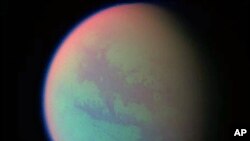U.S. and European space agency scientists have published details of the massive dunes on the surface of Saturn’s largest moon, Titan, that provide new insights about environmental conditions on the mysterious planet.
Scientists are interested in Titan because of its intriguing atmosphere and its surprising variety of Earth-like surface features. The moon also is the only known world in our solar system, besides Earth, with liquid on its surface. The liquid on Titan is methane, however, not water.
Researchers at NASA and the European Space Agency [ESA] say a new analysis of previous observations by the unmanned Cassini spacecraft orbiting Saturn indicates the size and spacing of Titan’s sand dunes are linked to the elevation and latitude where they formed.
The dunes’ size, shape and distribution also provide clues to understanding Titan’s climate and geology. The scientists say they hope the new findings also shed light on the moon’s puzzling methane cycle, which is comparable to the water cycle on Earth.
The Cassini data indicate that Titan’s massive dunes are 1 to 2 kilometers wide, stretch across the surface for hundreds of kilometers, and stand as much as 100 meters high. Dunes are the second-most common feature on the lunar landscape, covering 10 million square kilometers. That is slightly larger than the entire area of the United States.
The Cassini spacecraft has been orbiting Saturn since 2004.
The NASA and ESA scientists say the dunes on Saturn’s moon are visually similar to those found in Earth’s Kalahari and Arabian deserts. Instead of silicate granules, though, Titan’s sand likely is composed of frozen grains of methane. Titan’s lower elevations and latitudes are moist and have an abundance of sand. The dunes are wider and thicker than the dunes in the dryer conditions of higher altitudes and latitudes. The scientists believe the phenomenon is due to Saturn’s slightly elliptical orbit around the Sun that gives Titan its seven-year seasons.
With its 60 moons and spectacular rings, Saturn is more than 1.2 billion kilometers from Earth. It is the second-largest planet in the solar system behind Jupiter.
Saturn is the sixth most-distant from the Sun, after Jupiter, Mars, Earth, Venus and Mercury. Beyond Saturn are the ice-giant planets, Uranus and Neptune.
Dunes on Saturn Moon Reveal Clues to Its Environment













